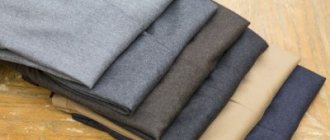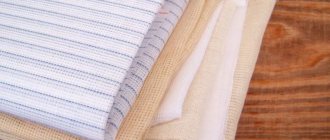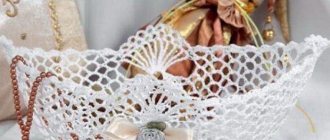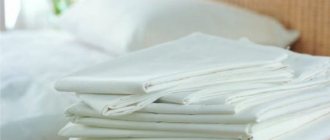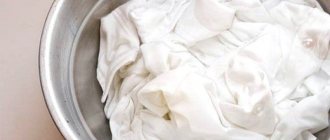To give clothes elegance and shine, sometimes you need to remember old methods. One of them is the application of starch to fabric. Skirts, shirts and underwear are rarely treated in this way today, so few people know how to do it. How to starch a skirt at home correctly?
When starch comes into contact with clothing, it forms a film that gives the item shape and volume. Doctors recommend starching your underwear to prevent it from becoming damp and absorbing harmful bacteria.
To process skirts, you can purchase special products in the store. There are compositions that can simply be sprayed onto a fabric or added to water. But you can prepare the solution at home yourself; any type of starch will do. Each type of fabric has its own method and dosage.
What proportions of starch are needed to starch a skirt?
You can prepare the solution at home yourself. Both potato starch and rice or corn starch are suitable for this. The proportions will depend on how hard you want it to be. If you just need to strengthen the bottom cover a little, starch is taken at the rate of 5 grams per 1 liter of water. For stronger support, it is necessary to prepare a concentrated solution in this way:
- dilute a tablespoon of starch in a glass of water at room temperature;
- pour the resulting solution into 0.5 liters of boiling water, stirring thoroughly so that there are no lumps;
- keep the solution on the fire for about 5 minutes;
- Strain the resulting liquid.
The finished composition is poured into a bowl of cold water.
Carrying out the procedure
Before you start starching a skirt, dress, cuffs and any other wardrobe items, you need to thoroughly wash and dry them.
We recommend: “Hello, fungus!”: about insulating walls from inside the house
Now both the skirt and the mortar are ready, which means it’s time to get to work! First of all, fill the basin with cold water; its volume should be sufficient to place clothes in it. After pouring the solution into a basin of water, place the skirt in it. Move the item in the liquid with the same movements as when rinsing and leave for a while.
The duration of soaking is determined by the desired hardness of the starched product: most often 3–10 minutes is enough.
After some time, remove the item from the liquid and, after wrapping it in gauze, gently squeeze it out. Now lay the skirt out on a straight surface, remove any wrinkles and let it dry. After drying, the item must be ironed.
To avoid long fuss with shaping a skirt or dress after washing, do not twist the product using great force. It is better to let the excess water drain on its own.
How to starch a tulle skirt
Please note that only the lower layers of the skirt need to be starched; the upper layers should not touch the composition.
The easiest way to starch a tulle skirt at home is by yourself. But there is a small nuance in this process: skirts made of this material consist of many layers. They do not need to be starched completely, otherwise they will turn out to be very large, and this will harm the appearance of the item. Only the lower layers need to be starched; the upper ones should not touch the composition.
Preparing the solution and things
The principle of operation of the product is simple: after rinsing the item, a durable film is formed on its surface, which holds the shape of the item. The more starch is added to the composition, the stiffer the skirt will be. The preparation of the base solution follows the following rules:
- You need to pour 5 g of starch into a mug and add a small amount of cold water. Next, the powder is mixed well so that there are no lumps in it.
- Boil 1 liter of water in a saucepan and pour the resulting slurry into it. The solution should simmer over low heat for another 5 minutes. At the same time, it must be stirred constantly.
- The resulting mass must cool before use.
- If lumps have formed in it, then the solution is filtered.
The consistency of the composition should resemble jelly.
Since starching a tulle skirt is not easy, you need to approach this process responsibly. The thing itself also requires preliminary preparation. First, you should wash it, since all the dust and dirt after the procedure will firmly stick to the fabric, giving it an unkempt appearance. It will be more difficult to remove contamination later.
After washing, the product must be rinsed thoroughly so that no powder remains on its surface. Otherwise, unsightly white streaks will appear on your clothes. After washing, the item dries well. If there are pills on the clothes, they should be eliminated. The quality of the starching procedure largely depends on the correct preparation of the product.
How to starch a mesh skirt
To starch a mesh skirt you will need 2 tablespoons of starch.
To give shape to mesh clothing, you need to dilute 2 tablespoons of the substance in a glass of water. The solution is mixed well, this is necessary to avoid the formation of lumps, then the resulting composition is poured into a liter of boiling water. The cooled mixture is filtered through cheesecloth, and the item is briefly dipped into the resulting solution. After this, it must be squeezed out well, but not twisted, as it will be difficult to smooth out the folds later.
The mesh skirt is dried with an iron. You need to iron it until it is completely dry.
Why are garments starched?
A starched dress retains freshness and volume longer. For example, in ballet, all tutus are necessarily treated with the mixture before the performance so that they keep their shape and do not “fall” during various steps and ples.
At home, the use of starch is very wide. Previously, after washing, men's shirts, namely, collars and cuffs, were necessarily processed. Children's dresses also went through this procedure to give them pomp and wear. Even snow-white bed linen was dipped into the solution to maintain freshness.
Modern housewives and fashionistas starch things to solve the following problems:
- get a clearer and more voluminous shape;
- prolong the feeling of freshness and lightness;
- ensure that the fabric wrinkles less and does not require constant ironing;
- stiffen collars and cuffs.
How to starch a child's skirt
A children's party always requires special preparation. To give a beautiful, fluffy shape to a children's dress for an important event, you need to do the following:
- dilute 4 tablespoons of starch in a glass of water;
- pour into a saucepan with 2 liters of boiling water;
- if lumps have formed in the solution, you need to strain the composition through gauze;
- pour the resulting mixture into a basin and rinse the product in it;
- After this, do not twist the skirt, but slightly squeeze it out;
- Iron the product until completely dry.
You can dry the item a little before ironing by laying it on a flat surface.
Preparatory activities
The starch solution is applied only to pre-washed items . Clean items can become dusty even after being stored for a short time. Sometimes the products show various stains or yellowing. In order to get rid of them, the skirt should be washed using special products. Grease stains are easily removed by dishwashing liquid previously applied to the fabric. Yellow areas can be removed with hydrogen peroxide.
First, let's carefully examine the product with which we will work. Its fabric must be absolutely clean. This is important because the starch solution, if it gets on dirt or dust, will change the white color and give it a yellow or gray tint. It will be possible to get rid of it only after the starch is completely removed.
Make sure that there are no streaks left on the surface of the fabric after rinsing the product . Residues of washing powder or gel can also change the color of the skirt.
How to starch a “tutu” skirt at home
After starching, the “pack” cannot be twisted or squeezed.
The tutu skirt should be tight. To do this, it must be completely immersed in the starch solution, and after the procedure is completed, carefully remove it. You cannot squeeze or twist the skirt. The fabric should dry a little, but not completely, because the item is ironed a little damp.
If you want the pack to not be too rigid, you can soak only the lower layers with the solution without touching the top. Then you will get volume, visual lightness and softness of the product.
Step-by-step instruction
The procedure does not involve complex actions. How to starch a skirt at home:
- completely immerse the product in starch paste;
- keep the skirt in the solution for 5-7 minutes;
- make sure that there are no dry areas left;
- carefully remove the product and leave to drain;
- straighten all folds and dry vertically.
To achieve the best result, slightly damp items should be ironed at low temperatures. It is strictly forbidden to use steaming or a spray to moisten the material after complete drying - water instantly destroys the starch layer. You can also starch clothes automatically. To do this, the starch paste is placed in the conditioner compartment, and then the washing mode suitable for the fabric is set. In this case, adding conditioner or stain remover is completely eliminated. After the procedure, you must thoroughly wipe the drum and glass of the machine.
Starch a satin skirt
Adding 1/2 teaspoon of salt to the starch solution will give the skirt a glossy shine.
Satin clothes are the most difficult to starch due to the density of the material. We prepare the solution from 2 tablespoons of starch and a glass of water, then dilute the composition in a liter of boiling water. Pour the resulting mixture into a bowl of water at room temperature and completely lower the skirt there. It should lie in the starch for 15–20 minutes.
After the procedure, dry the item on a hanger, then iron it with an iron and steam.
All things can be starched; they become more durable and less susceptible to contamination. If you use our grandmothers' secret and add 1/2 teaspoon of salt to the solution, you can give things a glossy shine.
Tips for the hostess
Do not completely dip a fluffy skirt made of several layers of tulle (mesh) into the solution. All layers treated with starch will create excess volume .
Leave the top layers in their natural, fluid state so they can respond to movement and wind. Treat several lower layers with starch mixture; their volume will be sufficient to create the desired fluffiness. You will get a very airy and beautiful skirt if you apply the mixture to each layer of fabric separately with a wide paint brush. This process is more labor-intensive than rinsing with starch, but the result is more interesting.
Ironing of starched fabrics is carried out on both sides. First they work on the back side, then on the front part.
With the rigid fixation method, let the skirt dry completely and only then iron it to avoid the appearance of yellow streaks when exposed to high temperatures..
If starch sticks to the soleplate of the iron, wipe it with turpentine. Silk fabrics can be made to keep their shape using gelatin or silicate glue, a teaspoon of which is diluted in 5 liters of water for soaking a petticoat or other things.
How to iron a leather skirt?
What to wear with a long blue skirt
How to return white underwear to its original appearance?
Stains are especially noticeable on white items, so simply washing them with detergent is not enough. It is necessary to use compounds that have a whitening effect. Read about what to do with a faded white item here.
Folk remedies
Laundry soap is effective in the fight against fresh stains. It contains fatty acids and caustic soda, which work well on stubborn stains. You can strengthen the recipe with citric or acetic acid.
Procedure:
- Grate natural laundry soap 72%.
- Dissolve it in warm water to form a paste of medium thickness.
- Add a little vinegar or citric acid to it.
- Apply the paste to faded areas.
- Leave for 4-5 hours.
- Wash the item as usual.
You can deal with the problem using dishwashing detergent. It contains surfactants that corrode paint molecules, making their connections less strong. Therefore, not a trace will remain of the stain.
Mode of application:
- mix dishwashing liquid and baking soda (2 tbsp and 1 tsp) in a separate container;
- apply the paste to the stain, leave to act for 3 hours;
- remove the composition with a soft brush;
- wash the item as usual.
Dishwashing detergent will remove the stain, and baking soda will bleach the fabric.
- lemon acid;
- salt;
- starch;
- crushed Aspirin tablet.
If the stain has already dried, hydrogen peroxide comes to the rescue. You can buy it at any pharmacy. It is not recommended to apply it in its pure form to things, so as not to spoil the fabric. Based on it, a solution is prepared at the rate of 50 ml per 5 liters of water.
Algorithm of actions:
- Pour the prepared solution into the basin. It should be warm, but not hot.
- Soak things in it for an hour.
- Rinse clothes and wash them as usual.
If the stains are not removed the first time, there is no need to wash the items. They are rinsed, a new solution is prepared and the procedure is repeated again.
Another effective remedy for removing stains from faded items is ammonia. A solution is prepared with it in which white fabrics are soaked:
- washing powder – 1 tbsp. l;
- ammonia - 1 tbsp. l;
- salt – 3 tbsp. l;
- warm water – 3 l.
The liquid is whipped until foam forms, after which the item is placed in it for 2 hours. After the specified time, the clothes are rinsed and washed as usual. The good thing about this recipe is that it can be used to wash delicate fabrics.
Household chemicals
When choosing a stain remover, you need to consider the type of fabric. If it is delicate, preference is given to the liquid form of the detergent. In other cases, you can use powder.
Professional stain removers that can be used for washing faded items:
- Vanish Oxi Action Gold. The oxygen bleach and stain remover included in the gel helps to quickly deal with even the most stubborn stains. Therefore, using it to wash faded items will not be difficult.
Fill a basin with water, add 1 measuring cap of detergent and soak the items for a while. For white fabrics, a maximum of 6 hours, after which the items are washed as usual. The cost of a 0.45 liter gel is 240 rubles.
Sarma Bleach Active. It does not contain chlorine and can be used for washing all types of fabrics. For 10 liters of water you will need 50 ml of detergent and the same amount of powder. Soak the item for 30-60 minutes, then wash as usual. The cost of the composition is about 80 rubles per package of 400 g of Bos Plus. This oxygen bleach enhances the action of laundry detergent, making it easy to remove even stubborn stains. For soaking, you need 40 g of bleach and the same amount of washing powder. Heavily faded items are kept in the solution for no more than 20 minutes, after which they begin normal washing. The higher the water temperature, the better the quality of the wash. The cost of a 600 g package is 160 rubles.
All of the products listed can be purchased in retail stores, in the household chemicals department, or ordered online.
The video will show you how to save a faded white item:
Alternative Methods
Sometimes you may not have starch on hand, and some fabrics cannot be treated with starch at all. In this case, sugar or gelatin can be an alternative.
Sugar
The sugar solution is prepared in different concentrations depending on the type of matter. The weakest is three tablespoons of sugar per glass of water, the densest is 1 glass of sugar per 1.5 glasses of water. The syrup must be brought to a boil, but be sure to ensure that it does not turn yellow. After cooling, the syrup will be ready for use.
Gelatin
Gelatin is suitable for adding additional rigidity to synthetic items - starch usually does not cope well with this. Another advantage of gelatin is that after drying it does not crumble at all.
To prepare the solution you will need one tablespoon of gelatin. It is filled with 10 ml of water and left to swell for half an hour. After this, add another half glass of water and heat the liquid until the gelatin is completely dissolved. Do not let it boil, otherwise the properties of gelatin will be destroyed and the mixture will become useless.
Some more useful starch tips:
- You should not starch your underwear, because its task is to give the body softness, comfort, warmth, and absorb sweat, and impregnation with starch prevents this.
- To give starched linen a slight shine, add a little table salt to the solution.
- Corn starch leaves smudges and streaks on dark items; it is best used for colored items.
- After starching, it is better to dry crocheted and knitted items on a thick fabric backing in a slightly stretched form, securing the shape of the product with needles.
- When starching embroidered items, too strong a solution gets clogged between the colored threads and spoils the appearance of the embroidery. For embroidered products you need to use soft starch.
- Adding a few drops of turpentine to the starch mixture will prevent starch particles from sticking to the iron while ironing.
- Before ironing, dry, starched linen can be sprayed with water from a spray bottle or wrapped in a damp cloth for a couple of hours.
- After removing the item from the starch mixture, do not wring it hard, this will give it maximum rigidity.
- To preserve the brightness of the colors of colored fabric, treat it with a starch composition only on the wrong side using a spray bottle or a special aerosol.
To visually study all the stages and methods of starching, and to understand in detail how to starch your favorite dress, watch the video. This simple procedure will significantly improve the appearance of any sewing or knitted product. The time spent on the starching process will return to you with the joy of a perfectly well-groomed item - a dress, tablecloth, bed linen. Using such things, you touch real noble nobility and royal luxury.
Professional products
There are a number of professional products that are used to starch women's evening dresses.
Spray or aerosol
When ironing clothes, special formulations produced in the form of a spray are often used. Their advantages include the following:
- things that are periodically sprayed with an aerosol retain their shape for a long time and do not lose freshness;
- products made from delicate materials no longer wrinkle much after treatment;
- the components that make up the aerosols prevent the fabric from absorbing sweat and other contaminants.
Which chair is best for a first-grader and how to choose it correctly
Powder or liquid
Sometimes people don't want to use aerosol sprays, so they use other products. Among housewives, washing liquids or powders with a starching effect are considered popular.
Wearing a skirt
When wearing any item treated with starch, you need to remember a little subtlety. A starched skirt will wrinkle much more. This is especially true for things treated with the most concentrated solution. Therefore, for example, a tutu skirt must be carefully monitored during transportation and storage.
If a large, ugly crease suddenly appears on the product, but you cannot replace it with anything, you can try to carefully iron the crease. Before doing this, spray the crease area with water and remember that you need to iron it from the wrong side.



